Birds are an integral part of Samangan’s natural heritage. Samangan is home to a rich and diverse variety of avian species, including waterfowl, game birds, raptors, and songbirds.
Birds are everywhere in Samangan, from the high mountain peaks to the low-lying plains. From the legendary Cinereous Vulture to the majestic Himalayan Monal to the colorful Plum-headed Parakeet, Samangan is a paradise for birdwatchers and nature lovers alike.
This guide will introduce you to the wondrous birds of Samangan and help you identify and appreciate them.
24 Birds to Watch in Samangan
Samangan is a province in northern Afghanistan that is rich in natural beauty and cultural heritage. It is also home to a diverse and fascinating array of birds, from migratory waterfowl to resident raptors.
Whether you are a seasoned birdwatcher or a curious traveler, Samangan offers you a unique opportunity to observe and appreciate some of the most amazing birds in the world.
Here are 24 birds that you should not miss when visiting Samangan.
1. Red-breasted Merganser
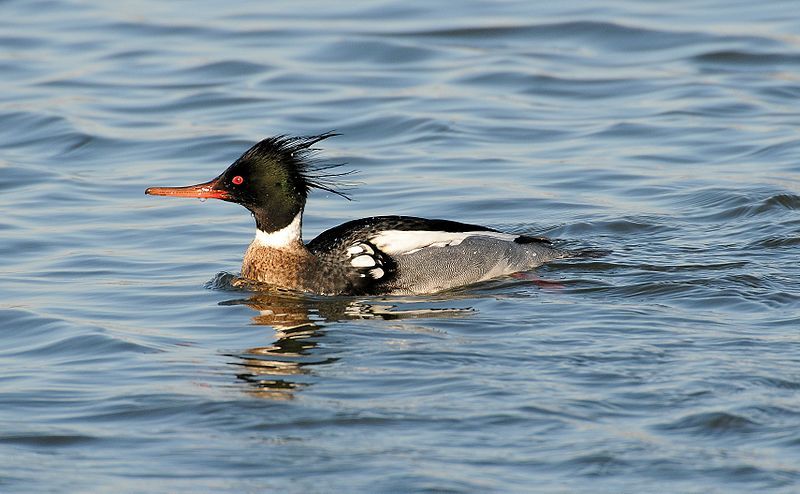
The red-breasted merganser is a duck species found all over the Northern Hemisphere. It is easily recognizable due to its unique coloration; the males of the species have bright red breasts, which is why they are commonly referred to as red-breasted mergansers.
This red breast is only visible during the breeding season when the males are in full breeding plumage. They take on a much more subdued coloration for the rest of the year.
The red-breasted merganser is common in many habitats, from rivers and lakes to coasts and estuaries. The species can be found in North America, Europe, and Asia and is a prevalent bird among birdwatchers due to its bright colors.
| Kingdom | Animalia |
| Phylum | Chordata |
| Class | Aves |
| Order | Anseriformes |
| Family | Anatidae |
| Genus | Mergus |
| Species | M. serrator |
2. Black Bellied Plover
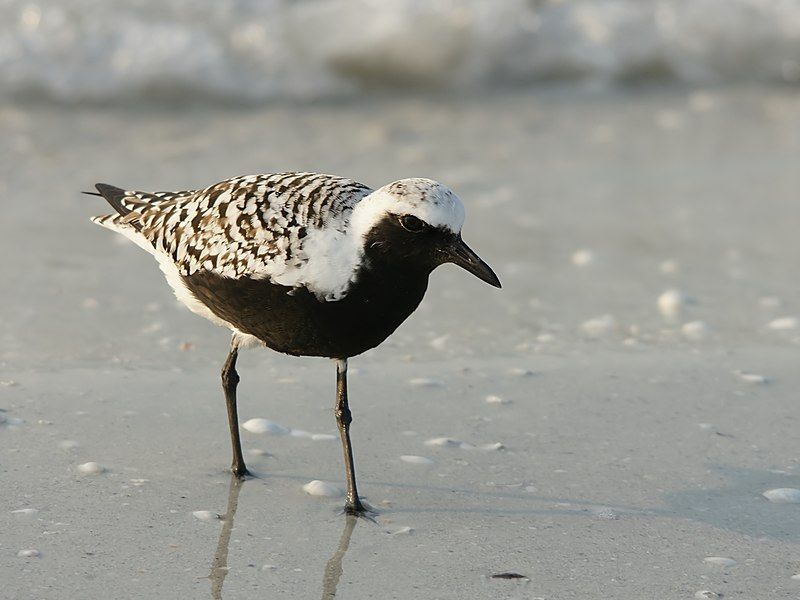
The grey plover is a species of shorebird found in many parts of the world. It is commonly referred to as the black-bellied plover in North America.
During the breeding season, this species is found in Arctic regions, but during other times of the year, it can be found in coastal areas worldwide. This makes the grey plover a long-distance migrant whose range covers nearly the globe.
The grey plover has a grayish-brown body, a black belly, and white wing bars. In breeding season, males have a black throat, face, and white crown. They also have a black breast band and a white supercilium.
These birds feed mainly on insects and other invertebrates, which they forage for in shallow waters. They will also eat plant material and some grains. The grey plover is a social species, often found in large flocks during the non-breeding season.
This species is considered to be of least concern regarding conservation status due to its wide range and large population.
| Kingdom | Animalia |
| Phylum | Chordata |
| Class | Aves |
| Order | Charadriiformes |
| Family | Charadriidae |
| Genus | Pluvialis |
| Species | P. squatarola |
3. Black-winged Stilt
The black-winged stilt is a type of wading bird found in many parts of the world. It belongs to the avocet and stilt family, a group of shorebirds characterized by their extremely long legs. The scientific name for the black-winged stilt is H.
Himantopus, and this species, is almost entirely cosmopolitan, meaning it can be found worldwide. The black-winged stilt is an unmistakable bird due to its long legs and distinctive black wings that contrast starkly with its white body.
It is usually seen foraging in shallow bodies of water, sometimes in large flocks, and it is an omnivorous species, meaning it can feed on plant and animal matter.
The black-winged stilt is essential for conserving wetlands and other wetland habitats, as its presence can indicate a healthy environment. The black-winged stilt is a magnificent bird, and its long legs and wingspan make it a sight.
Its beauty and importance to the environment make it a species worth protecting, and it can be found in many parts of the world. Its scientific name, H. Himantopus, reminds us of the unique and beautiful species that comprise our planet’s avian diversity.
| Kingdom | Animalia |
| Phylum | Chordata |
| Class | Aves |
| Order | Charadriiformes |
| Family | Recurvirostridae |
| Genus | Himantopus |
| Species | H. himantopus |
4. Ferruginous Duck
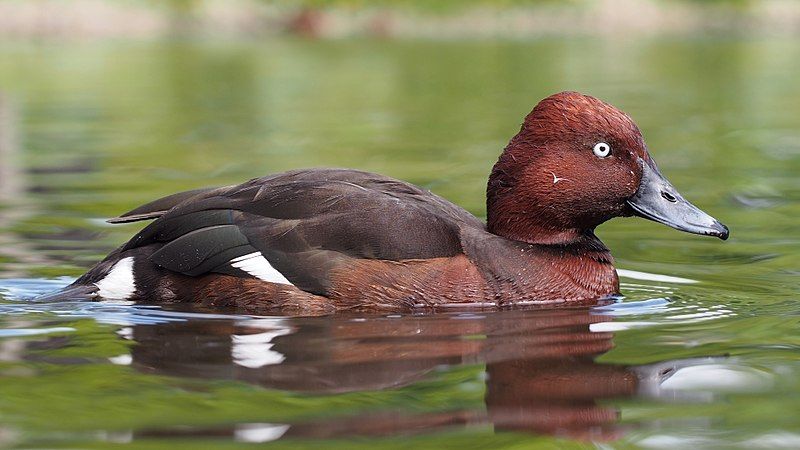
The ferruginous duck is a species of medium-sized diving duck native to Eurosiberia.
Its scientific name is derived from two sources – the Greek word “Lithuania,” an unidentified seabird mentioned by authors including Hesychius and Aristotle, and the Russian term “nyrok,” which translates to ‘duck.’
This species has various common names, including ferruginous pochard, common white-eye, and white-eyed pochard. The ferruginous duck is a medium-sized bird with a body length of 40 and 46 centimeters.
It has a striking, rusty-brown plumage, a white eye ring, and a grey bill. The male’s body is slightly darker than the female’s, with a black pectoral patch.
The female ferruginous duck has a paler chestnut head and neck with a white eye-ring. This species is mainly found in wetlands, ponds, and lakes. It feeds primarily on insects, crustaceans, and mollusks, which it finds by foraging on the water’s surface.
It is generally a shy and wary species, rarely observed in the wild. The IUCN Red List of Threatened Species lists the ferruginous duck as near threatened. Its population is decreasing due to habitat loss, degradation, and overhunting.
Conservation efforts are being made to protect this species, including creating protected areas and enforcing hunting regulations.
| Kingdom | Animalia |
| Phylum | Chordata |
| Class | Aves |
| Order | Anseriformes |
| Family | Anatidae |
| Genus | Aythya |
| Species | A. nyroca |
5. Garganey
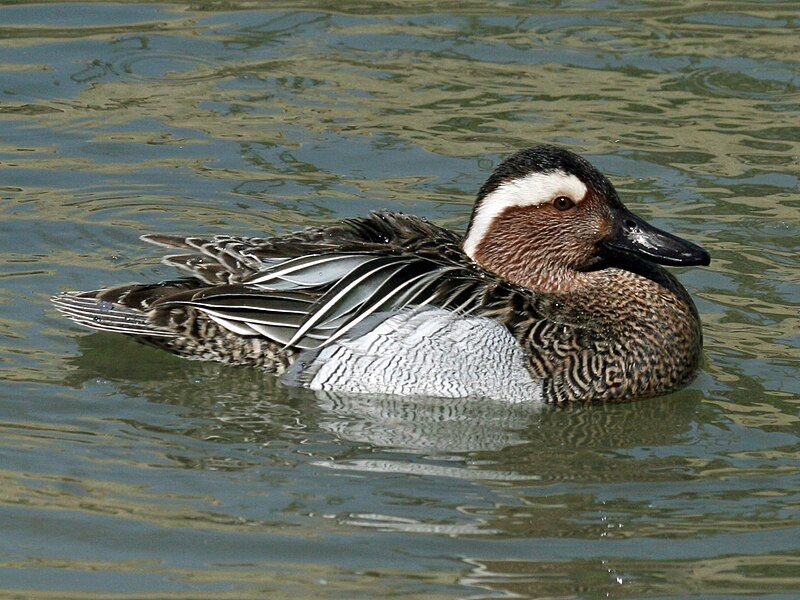
The garganey is a species of small duck that breeds in a wide range of areas across Europe and the Palearctic region. It is a migratory species, moving from its breeding grounds to different areas during the winter.
This species is known to travel to southern Africa, India, Bangladesh, and Australasia when the winter season arrives in the Northern Hemisphere. Large flocks of garganeys can be seen in these areas during this time.
The migratory patterns of the garganey are an incredible sight to behold. They journey to the Southern Hemisphere every year to escape the cold and take advantage of the warmer climates in these regions.
Once there, the garganeys form large flocks, which can be seen flying across the skies and feeding in the wetlands. These ducks form strong social bonds with one another while also looking out for any potential predators.
This behavior benefits both the individual members of the flock and the species as a whole. It is also important to note that the garganey species depend highly on wetlands and water bodies for survival.
Overall, the garganey is a fascinating species of duck that has adapted to the changing seasons by migrating to different areas to survive the winter.
It is a species that has been able to thrive in a wide range of habitats, and its yearly journey is genuinely captivating to observe.
| Kingdom | Animalia |
| Phylum | Chordata |
| Class | Aves |
| Order | Anseriformes |
| Family | Anatidae |
| Genus | Spatula |
| Species | S. querquedula |
6. Marbled Teal
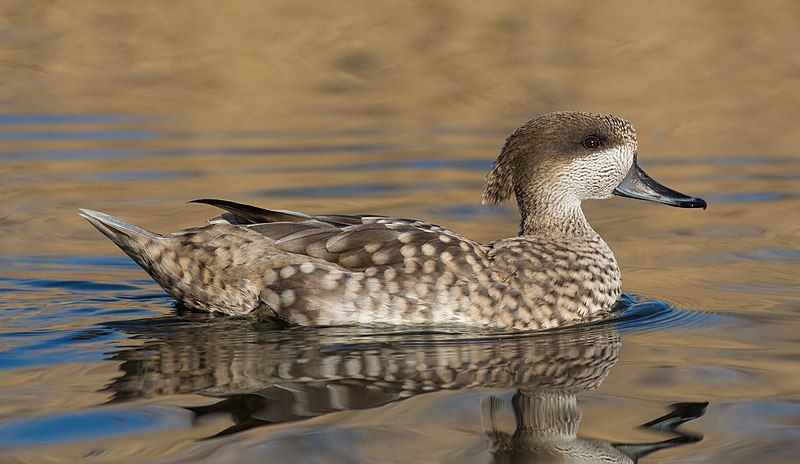
The Marbled Duck, also known as the Marbled Teal, is a waterfowl species native to southern Europe, northern Africa, and western and central Asia. It belongs to the Anatidae family, which includes most duck species, geese, and swans.
It is a medium-sized species of duck, and its scientific name, Marmaronetta angustirostris, comes from the Greek words Marmaris, meaning marbled, and Netta, meaning duck.
The Latin part of the name, angustus, translates to narrow or small, while -rostris means billed. The Marbled Duck is characterized by its distinctive marbled pattern of brown, white, and black feathers that cover its body.
It has a slender bill, a slight hook at the end, and a black crown with a white eyeline. Its legs are greenish-gray, and its eyes are dark.
Its wings are dark, in flight,t with a white patch at the base. The Marbled Duck is a migratory species usually found in shallow wetlands such as marshes, lakes, reservoirs, and ponds. It feeds on aquatic plants, invertebrates, and small fish.
The female lays eggs in a shallow depression lined with vegetation, and the chicks hatch after about three weeks. The Marbled Duck is a globally common species with a stable population.
However, it is threatened by habitat loss due to agricultural and urban development and hunting and predation by introduced species. It is also vulnerable to oil spills and other environmental contaminants.
Conservation efforts include habitat protection and management, as well as the control of hunting and predation.
| Kingdom | Animalia |
| Phylum | Chordata |
| Class | Aves |
| Order | Anseriformes |
| Family | Anatidae |
| Genus | Marmaronetta |
| Species | M. angustirostris |
7. White-headed Duck
The white-headed duck is an aquatic bird approximately 45 cm in length. It is easily recognizable by its distinct coloration; the male has a white head with a black crown, a blue bill, and reddish-grey plumage.
The female has a dark bill and is generally duller in color. This duck species prefers to inhabit lakes with open water and dense vegetation along the margin. This provides them a safe location to feed, nest, and raise their young.
The vegetation also offers protection from predators, while the open water gives them a place to dive and hunt for food. The white-headed duck is a migratory species that will travel to warmer climates in winter.
It is also an endangered species, mainly due to the loss of its habitat from human activity. Conservation efforts are being undertaken to help protect and restore the white-headed duck’s natural habitat so it can continue to thrive in the wild.
| Kingdom | Animalia |
| Phylum | Chordata |
| Class | Aves |
| Order | Anseriformes |
| Family | Anatidae |
| Genus | Oxyura |
| Species | O. leucocephala |
8. Greater Flamingo
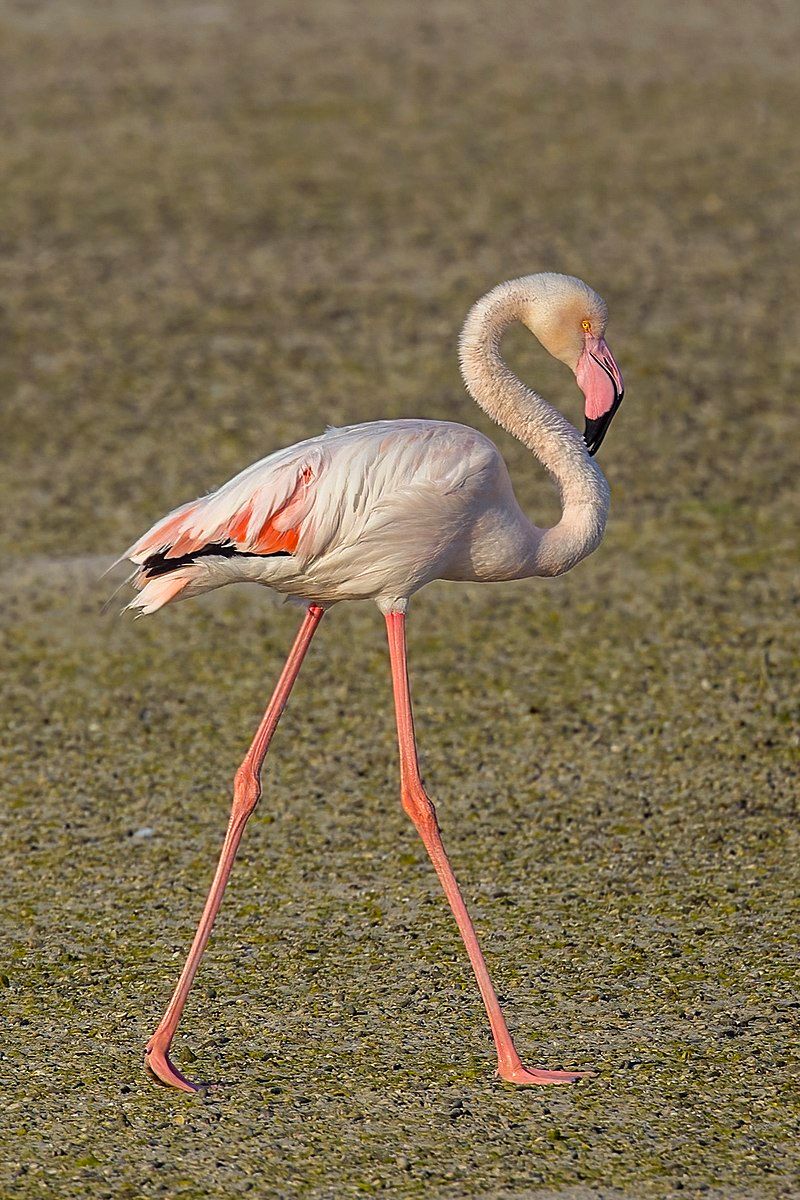
The greater flamingo is the most significant and widespread species of the family.
They are usually found in the Old World, with a wide range of habitats across Northern and Sub-Saharan Africa, the Indian Subcontinent, the Middle East, the Levant, the Persian Gulf, the Gulf of Aden, the Red Sea, and parts of Southern Europe.
These birds inhabit diverse habitats, including coastal saline lagoons, intertidal mudflats, inland freshwater lakes, and alkaline ponds. They are often found in large flocks and can be seen in wetland areas, especially around the Mediterranean.
Flamingos feed on crustaceans, mollusks, other aquatic invertebrates, small fish, and some plant material. Their long legs and necks make them well-suited for wading in shallow waters, and their specialized bill helps them filter out food from the water.
The presence of greater flamingos is an indicator of a healthy wetland environment.
| Kingdom | Animalia |
| Phylum | Chordata |
| Class | Aves |
| Order | Phoenicopteriformes |
| Family | Phoenicopteridae |
| Genus | Phoenicopterus |
| Species | P. roseus |
9. Rock Pigeon
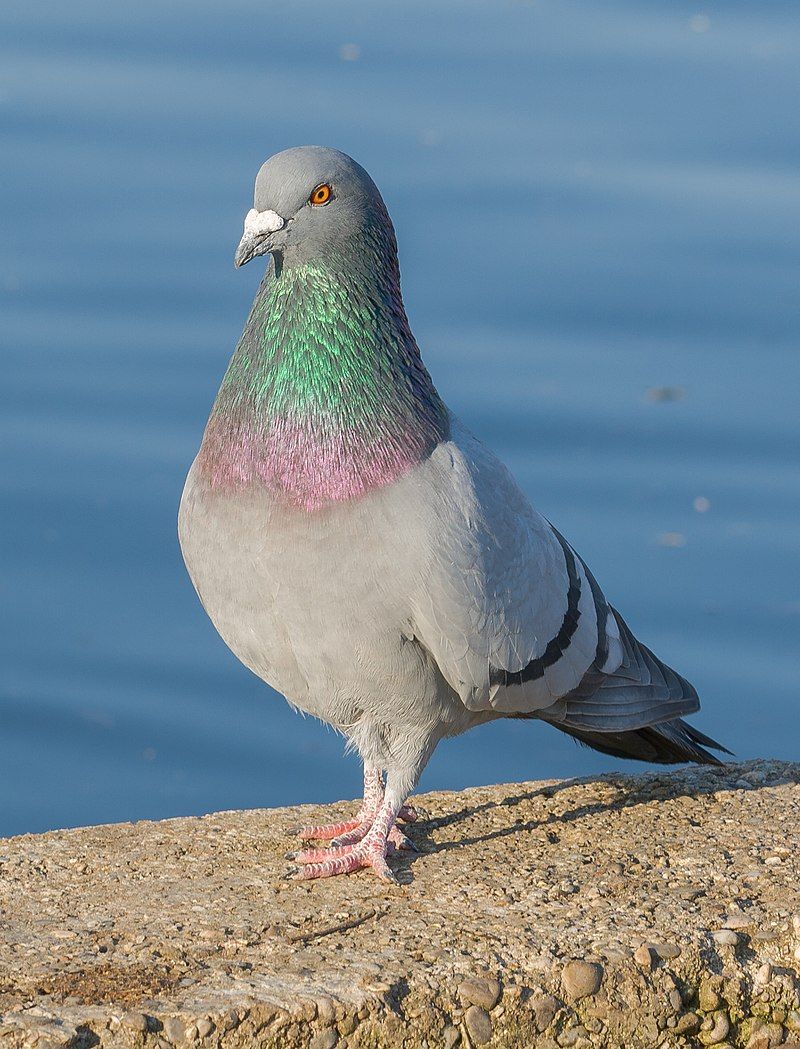
The rock dove, rock pigeon, or common pigeon is a bird species in the Columbidae family. It is often referred to as a “pigeon” in everyday conversation. This pigeon species is the ancestor of the domestic pigeon, which was domesticated by humans.
The domestication of this species led to many of them being released into the wild, causing the population of feral pigeons to grow in many regions of the world.
Feral pigeons are descendants of the domesticated rock dove and live in large numbers in urban areas, where they can often be seen scavenging for food.
| Kingdom | Animalia |
| Phylum | Chordata |
| Class | Aves |
| Order | Columbiformes |
| Family | Columbidae |
| Genus | Columba |
| Species | C. livia |
10. Eurasian Coot
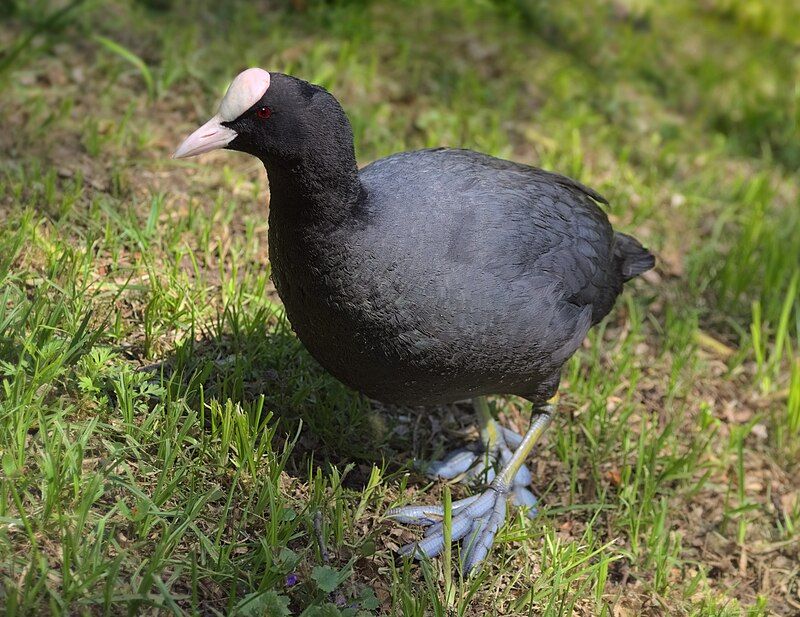
The Eurasian coot is a species of bird belonging to the rail and crake family Rallidae. It is a common sight in many parts of the world, with its range spanning Europe, Asia, Australia, New Zealand, and parts of North Africa.
This bird species is easily recognizable due to its slaty-black body, glossy black head, and white bill with a white frontal shield. The Eurasian coot is an aquatic bird often seen wading in shallow waters across its range.
Its diet consists of vegetation, aquatic plants, and insects, which it forages in shallow waters. The coot is an excellent swimmer, with its webbed feet giving it an advantage when swimming in fast-moving water.
It can also fly, although its wings are short and not particularly strong. The Eurasian coot is a social bird often found in large flocks near bodies of water. Its call is a hoarse, clucking sound, which can be heard miles away.
Breeding occurs in the spring and summer, with the males displaying their white frontal shields, hoping to attract a mate. The female lays a clutch of 5-7 eggs, which she incubates for up to three weeks before they hatch.
The chicks are capable of flight within 2-3 weeks of hatching. The Eurasian coot is a fascinating bird species, and its presence is a welcome sight in many parts of the world.
Its adaptability to different habitats and its extensive range make it a species that is likely to remain common in the future.
| Kingdom | Animalia |
| Phylum | Chordata |
| Class | Aves |
| Order | Gruiformes |
| Family | Rallidae |
| Genus | Fulica |
| Species | F. atra |
11. Cranes
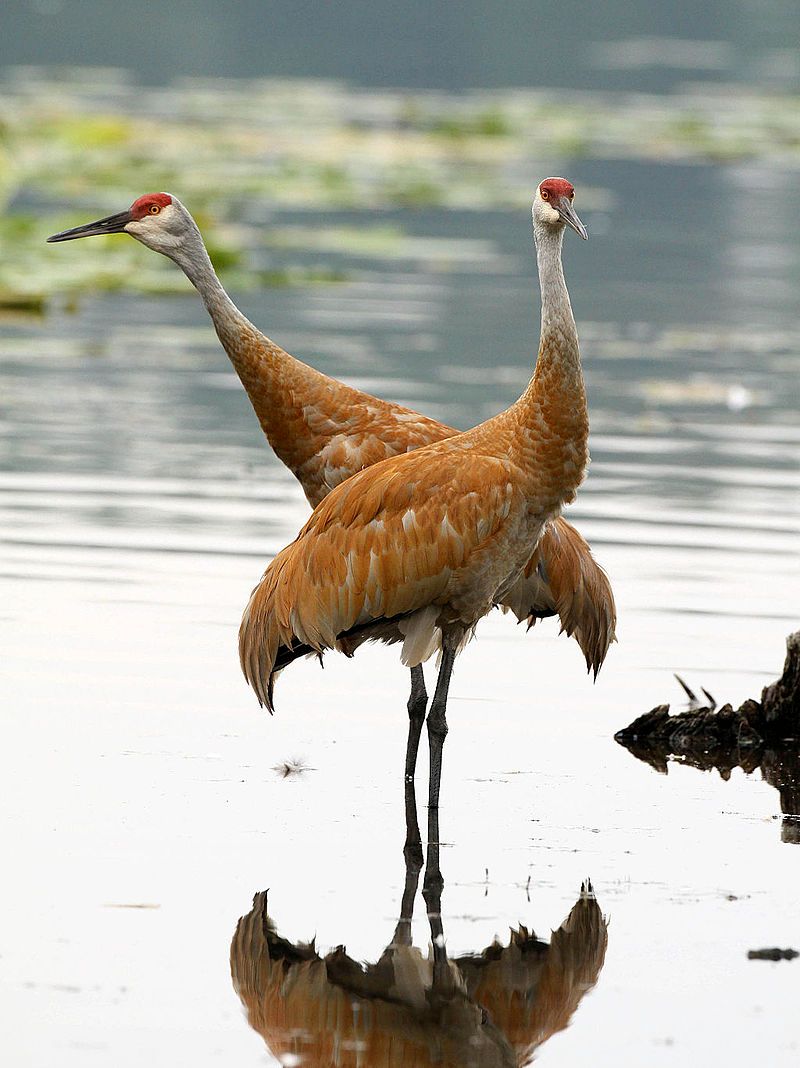
Cranes are a unique type of bird belonging to the family Gruidae and the order Gruiformes. Cranes are large and have long legs and necks. Fifteen species of cranes can be found in three distinct genera: Antigone, Balearica, and Grus.
Cranes are different from herons, which resemble in appearance but not behavior – while herons retract their necks while flying, cranes keep their necks stretched out. This helps them to spot predators and food sources more quickly from a greater distance.
Cranes also have a more powerful wingspan and can fly farther than herons.
| Kingdom | Animalia |
| Phylum | Chordata |
| Class | Aves |
| Order | Gruiformes |
| Family | Gruidae |
12. Ibisbill
The ibisbill is a unique bird belonging to its own family, Ibidorhynchidae. It is a grey-colored bird with a white belly, red legs, and a long, curved bill.
Its face and breasts are black and found on the shingle riverbanks of the high plateau of central Asia and the Himalayas.
This bird is related to the waders, a group of shorebirds that feed on mud and sandflats while wading in shallow water. The ibisbill is a relatively large bird, measuring about 35 cm in length.
It has a distinctive long, curved bill used to search for food along the riverbanks. Its plumage is mainly grey, with a white belly, black face, and breast band.
Its legs are a bright red color. The ibisbill is an adaptation of the wader family to the extreme high-altitude environment of central Asia and the Himalayas. It is found in these regions’ cold, fast-flowing rivers and feeds mainly on small invertebrates.
Its long bill is well adapted for digging in the gravel and sand of the riverbed to find these food sources. The ibisbill is a unique species whose long-term survival depends on conserving its riverbank habitats.
It is currently listed as Near Threatened by the IUCN and is vulnerable to habitat destruction, degradation, and hunting. Conservation efforts should focus on protecting the riverbanks where the ibisbill can find food and shelter.
| Kingdom | Animalia |
| Phylum | Chordata |
| Class | Aves |
| Order | Charadriiformes |
| Family | Ibidorhynchidae |
| Genus | Ibidorhyncha |
| Species | I. struthersii |
13. Baikal Teal
The Baikal teal is a species of dabbling duck found in eastern Russia and East Asia. Its scientific name is Anas formosa, the bimaculate or squawk duck.
It is a small duck, measuring about 17 to 19 inches in length, with males having a distinctive pattern of white and black spots along their back.
It has a short, black bill and a dark gray body. The Baikal teal is a migratory species, breeding in Russia during summer and then migrating south to East Asia for the winter.
It can be seen in marshes and ponds during the breeding season, feeding on aquatic plants, insects, and mollusks.
During the winter, they are found in coastal areas, tidal flats, and shallow lakes. The Baikal teal is an essential species in terms of conservation, as it is listed as Near Threatened on the IUCN Red List.
Currently, the biggest threats to this species are habitat destruction and hunting. Conservation efforts are focusing on protecting the Baikal teal’s habitat and reducing hunting pressure to help protect the Baikal teal.
| Kingdom | Animalia |
| Phylum | Chordata |
| Class | Aves |
| Order | Anseriformes |
| Family | Anatidae |
| Genus | Sibirionetta |
| Species | S. formosa |
14. Bar-headed Goose
The bar-headed goose is a species native to Central Asia known for its impressive migratory pattern. It breeds in large colonies near mountain lakes and can lay three to eight eggs in a ground nest at a time.
During the winter, the bird migrates south as far as peninsular India. The bar-headed goose is especially noteworthy for its ability to reach extreme altitudes while traveling across the Himalayas during its annual migration.
This impressive feat is made possible by the bird’s efficient use of oxygen and its light body weight. The bar-headed goose is one of the most resilient and hardy birds in the avian world, and its remarkable adaptability and migratory pattern make it a fantastic sight to behold.
| Kingdom | Animalia |
| Phylum | Chordata |
| Class | Aves |
| Order | Anseriformes |
| Family | Anatidae |
| Genus | Anser |
| Species | A. indicus |
15. Common Pochard
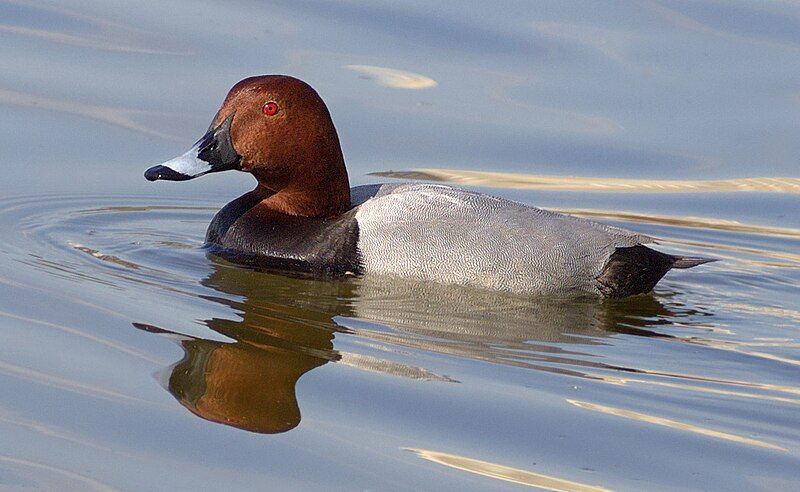
The Common Pochard is a type of diving duck found in various parts of the world. Its scientific name is derived from the Greek “Lithuania” and Latin “feria,” which both mean “wild game.”
The term “Lithuania” was first used by ancient authors such as Hesychius and Aristotle when referring to an unidentified seabird. The Latin “farina” is derived from “virus,” which means “wild.”
This name reflects the wild nature of the Common Pochard and the fact that it is a type of wild game. The Common Pochard is a medium-sized duck with a dark greyish-brown plumage and a pale brown head. The male has a light blue beak, while the female has a brown beak.
It usually feeds on aquatic plants and small animals such as insects, crustaceans, and mollusks. It is a strong swimmer and prefers to dive for food rather than feed on the surface.
It is often seen in large flocks and can be found in ponds, lakes, marshes, and other bodies of water. The Common Pochard is a migratory duck found in Europe and Northern Asia during winter and Northern Africa during summer.
It is an essential species for hunters, as its meat is considered good quality. It is also an important species for conservation efforts, as it is listed as vulnerable on the IUCN Red List.
Overall, the Common Pochard is a medium-sized diving duck with a scientific name derived from Greek and Latin terms meaning “wild game.” It is an essential species for hunters and conservationists alike, and its migratory nature makes it a fascinating species to observe.
| Kingdom | Animalia |
| Phylum | Chordata |
| Class | Aves |
| Order | Anseriformes |
| Family | Anatidae |
| Genus | Aythya |
| Species | A. ferina |
16. Cotton Pygmy Goose
The Cotton Pygmy Goose, also known as the Cotton Teal, is a duck species native to Asia and Southeast Asia. It is a relatively small species, measuring about 17-20 inches long. These birds prefer open wetlands and often breed in shallow, grassy marshes.
They usually feed on various aquatic animals, such as insects, crustaceans, mollusks, and fish. The Cotton Pygmy Goose is a migratory species. During the winter and spring, they migrate to Queensland, Australia, where they are known as the White-Quilled Pygmy Goose.
This species is considered a minor concern on the IUCN Red List, meaning it is not at risk of extinction. The Cotton Pygmy Goose is an exciting duck species due to its small size and wide range.
It can be found across parts of Asia and Southeast Asia and in Australia during the winter and spring. It is a species of most minor concern and is not currently at risk of extinction.
| Kingdom | Animalia |
| Phylum | Chordata |
| Class | Aves |
| Order | Anseriformes |
| Family | Anatidae |
| Genus | Nettapus |
| Species | N. coromandelianus |
17. Falcated Duck
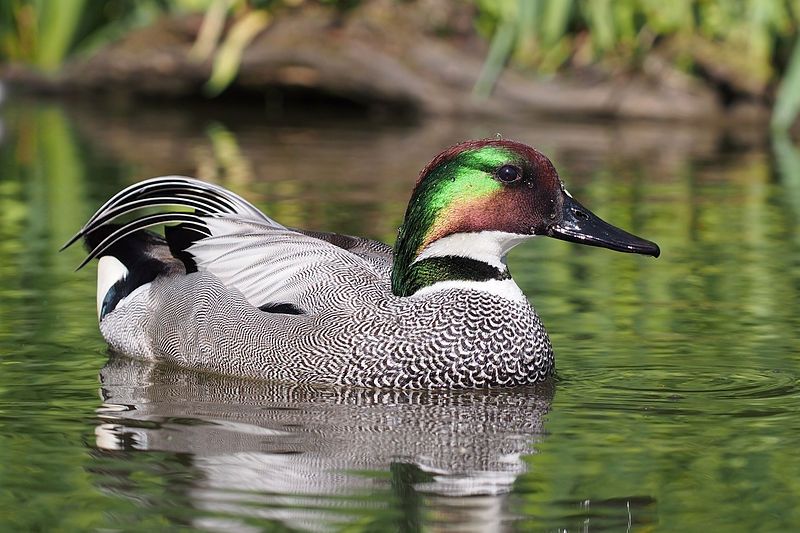
The falcated duck, or falcated teal as it is also known, is a species of medium-sized dabbling duck. It is found in the east Palearctic region, also known as the Near East, which covers the eastern parts of Europe, North Africa, and Asia.
The falcated duck is a species of the Gadwall family, which means it is of a similar size to the Gadwall, a species of dabbling duck commonly found in temperate regions of Europe and Asia.
The falcated duck is mainly known for its colorful plumage, ranging from light to dark brown or black.
It has a distinctive white patch on its head, a white stripe running down its back, and a long and narrow tail, giving it the appearance of a falcon in flight.
The falcated duck is a migratory species, breeding in parts of Russia and China and spending winters in Southeast Asia and India. It feeds mainly on aquatic vegetation, insects, and mollusks and is an important prey species for many predators, such as hawks, falcons, and owls.
| Kingdom | Animalia |
| Phylum | Chordata |
| Class | Aves |
| Order | Anseriformes |
| Family | Anatidae |
| Genus | Mareca |
| Species | M. falcata |
18. Gadwall
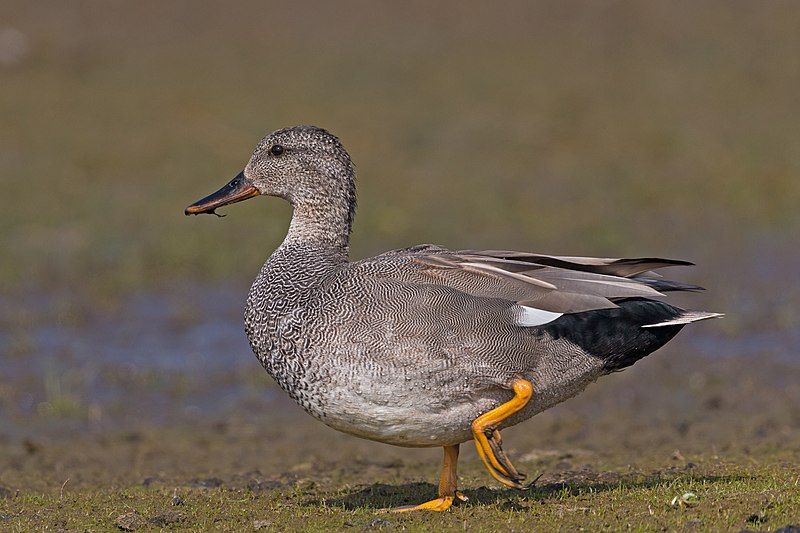
The gadwall is a species of duck belonging to the family Anatidae. It is one of the most widespread dabbling ducks in the world, found on every continent except Antarctica. It is easily distinguished from other dabbling ducks due to its unique coloration and behavior.
The gadwall is usually gray, with a white belly, head, and brownish-gray back. The male of the species has a blackish-green head and chest, while the female is usually more brown.
The gadwall is known for its skittish behavior, often flying away when disturbed. It feeds on aquatic vegetation, small invertebrates, and seeds. It usually nests in shallow wetlands and is a strong swimmer and diver.
The gadwall is a common sight in many wetlands and is often seen in large flocks. It is a valuable food source for many species of birds and mammals and a famous game bird.
| Kingdom | Animalia |
| Phylum | Chordata |
| Class | Aves |
| Order | Anseriformes |
| Family | Anatidae |
| Genus | Mareca |
| Species | M. strepera |
19. Greater Scaup
The greater scaup is a mid-sized diving duck inhabiting the world’s northernmost regions, including Alaska, northern Canada, Siberia, and parts of Europe. It is often called the bluebill in North America or the European scaup.
The greater scaup is more significant than its close relative, the lesser scaup, and it spends its summer months breeding in these regions. During the winter months, the greater scaup migrates south, often to the Great Lakes and coastal areas of the United States.
The greater scaup is a black and white duck with a blue bill and a distinctive white patch on its head. It feeds on small invertebrates such as mollusks, crustaceans, aquatic insects, and some plant matter. They are strong swimmers and often dive for their food.
They are also highly social and can often be seen in large groups. The greater scaup is an essential species for recreational and commercial duck hunters.
It is also an essential species for conservation, as its population has declined in recent years due to various factors. These include habitat loss, pollution, and overhunting. Conservation efforts are currently underway to protect the greater scaup and its habitat.
| Kingdom | Animalia |
| Phylum | Chordata |
| Class | Aves |
| Order | Anseriformes |
| Family | Anatidae |
| Genus | Aythya |
| Species | A. marila |
20. Greater White-fronted Goose
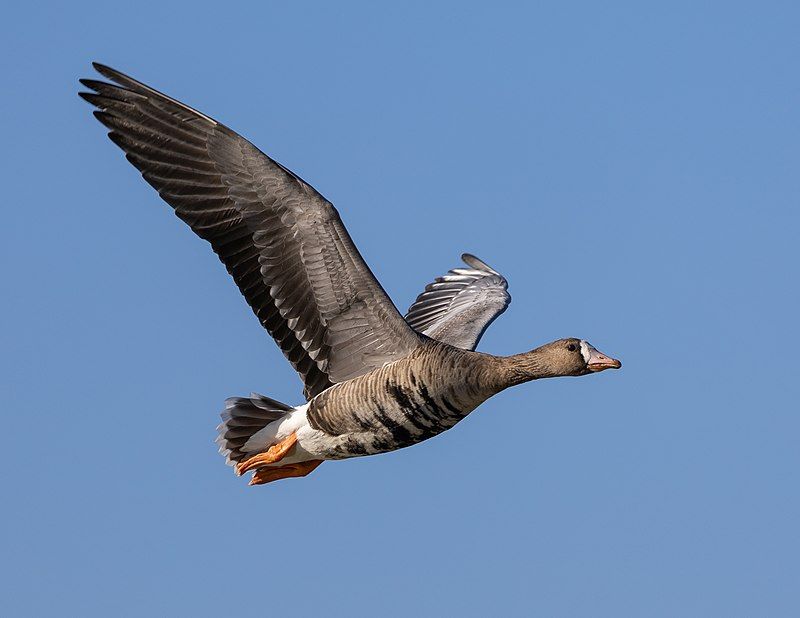
The greater white-fronted goose is a goose species found in the Northern Hemisphere. It is closely related to the smaller, lesser white-fronted goose. It earned its name from the white feathers found around the base of its bill.
The Latin term ‘albus’ means white, and ‘front’ means forehead. Therefore, ‘albifrons’ comes from combining the two words, meaning ‘white forehead.’
The greater white-fronted goose is a medium-sized goose with a wingspan of around 75 cm and a body length of around 50 cm. It has a distinctive yellow bill with a pink base and a white forehead.
Its upperparts are dusky grey-brown, while its underparts are lighter grey. It also has a white stripe across its throat and a black tail. The greater white-fronted goose is an important species to many ecosystems and is a species of particular concern in many areas.
It is widely distributed across the Northern Hemisphere but mainly in northern Europe, Asia, and North America.
Its diet consists mainly of vegetation, such as grasses and sedges, aquatic plants, and insects. The greater white-fronted goose is an important species and is an integral part of many ecosystems.
Through their presence, they help to maintain healthy habitats and provide important food sources to other species. Ensuring these birds’ continued survival and health is essential, as they are a valuable part of the environment.
| Kingdom | Animalia |
| Phylum | Chordata |
| Class | Aves |
| Order | Anseriformes |
| Family | Anatidae |
| Genus | Anser |
| Species | A. albifrons |
21. Mute Swan
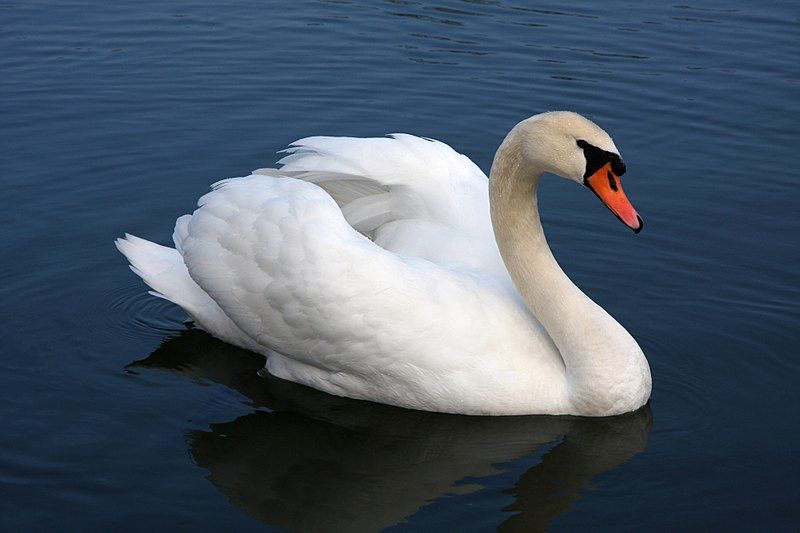
The mute swan is a swan species belonging to the waterfowl family Anatidae. It is native to a large section of Europe, Asia, and the northern parts of Africa. This species of swan is most recognizable by its white feathers and orange-red bill.
They are usually found in wetlands, slow-flowing rivers, lakes, and estuaries. Mute swans are social birds generally seen in pairs or small groups but may gather in larger flocks during the winter months.
Mute swans are omnivores, feeding mainly on aquatic plants, aquatic invertebrates, and small fish. They are known to be quite territorial and will defend their nesting areas from other birds and animals.
Mute swans have a long lifespan, with some living up to 20 years in the wild. They are also quite large, with a wingspan of up to 2.5 meters. The mute swan is an essential species for wetland conservation, as it helps to keep wetlands healthy and productive.
| Kingdom | Animalia |
| Phylum | Chordata |
| Class | Aves |
| Order | Anseriformes |
| Family | Anatidae |
| Genus | Cygnus |
| Species | C. olor |
22. Red-crested Pochard
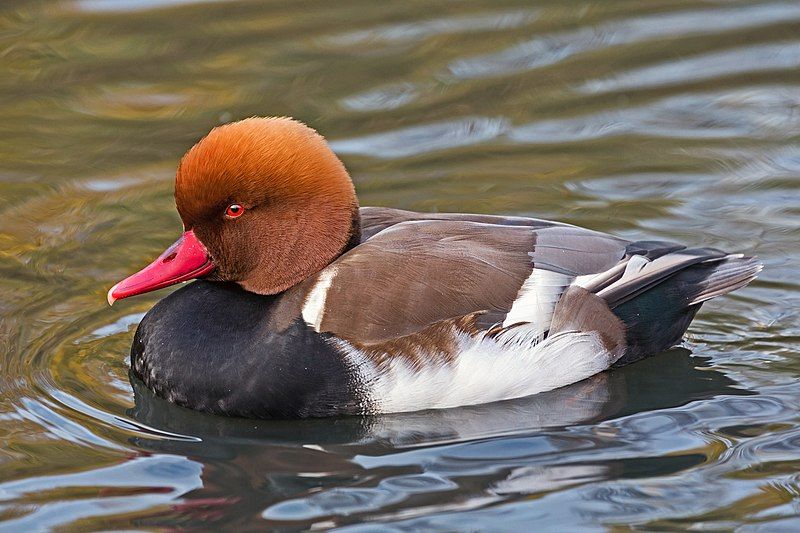
The red-crested pochard is a species of large diving duck found in many parts of the world. It is easily identified by its distinctive red crest, which gives the species its name.
The scientific name for the red-crested pochard is derived from the Greek word Netta, meaning “duck,” and the Latin word Rufina, meaning “golden-red.” This is a fitting name for the duck, as its red crest gives it a golden-red hue.
The red-crested pochard is common in wetland areas such as lakes, marshes, and ponds, where it can be seen diving for food. It feeds mainly on aquatic plants, insects, and small fish. The duck is a migratory species, traveling between its summer and winter habitats.
In addition to its striking appearance, the red-crested pochard is known for its distinctive vocalizations. Its call is a series of low-pitched quacks that can be heard from long distances.
This loud, distinctive sound is an integral part of the duck’s communication with other members of its species.
The red-crested pochard is an essential species in wetland ecosystems, providing food for many other species and helping to maintain a healthy balance in the environment. Its popularity has made it a protected species in many parts of the world.
| Kingdom | Animalia |
| Phylum | Chordata |
| Class | Aves |
| Order | Anseriformes |
| Family | Anatidae |
| Genus | Netta |
| Species | N. rufina |
23. Ruddy Shelduck
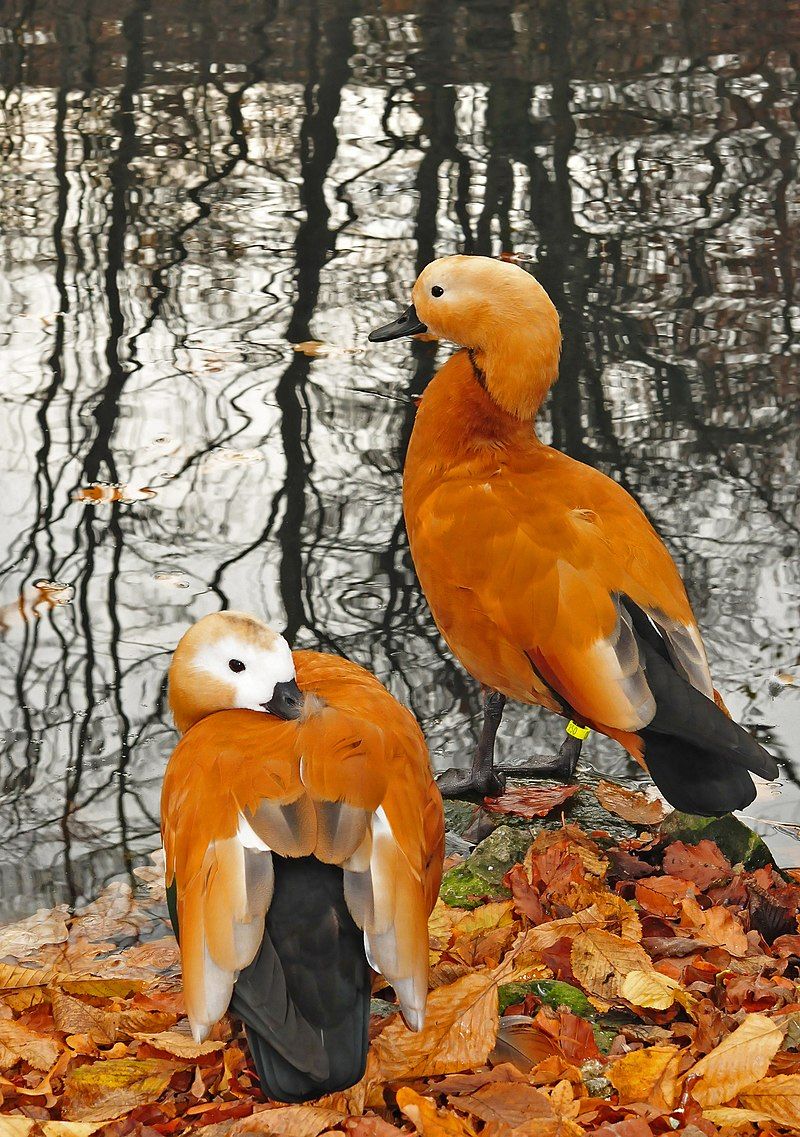
The ruddy shelduck, also known as the Brahminy duck, is a species of waterfowl belonging to the family Anatidae. It is distinctive in its physical appearance, measuring around 58 to 70 cm in length and having a wingspan of 110 to 135 cm.
The ruddy shelduck is found in Europe, Asia, and Africa. It enjoys large, open wetlands such as lakes, marshes, and floodplains but can also be found in smaller ponds, pools, and canals.
The ruddy shelduck is a reasonably large bird with a long neck, a long, pointed tail, and a short, broad bill. The bird’s body is predominantly reddish-brown, while the head is grey-brown.
The underparts are dark brown, and the wings have a distinctive white patch at the base. The bird’s legs are dark gray. The ruddy shelduck is a social bird, often seen in several dozen or more flocks.
The birds feed mainly on aquatic vegetation but will also eat insects, grains, and other small prey.
They are strong swimmers who can dive to great depths for food. The breeding season for the ruddy shelduck is usually between April and July, during which time they lay 5 to 10 eggs.
The eggs are incubated for 28 to 30 days, after which the chicks are ready to leave the nest. The chicks can fly after about 45 days of age. The ruddy shelduck is a magnificent bird that is worth the effort of looking out for.
Its distinctive reddish-brown body and white wing patch make it stand out among other waterfowl. With its strong social bonds and ability to dive for food, it is an exciting bird to observe in the wild.
| Kingdom | Animalia |
| Phylum | Chordata |
| Class | Aves |
| Order | Anseriformes |
| Family | Anatidae |
| Genus | Tadorna |
| Species | T. ferruginea |
24. Smew
The smew is a duck species and the only living member of the genus Mergellus.
The name “Mergellus” is derived from the word “Mergus,” which is Latin for “seagull.” Its scientific name, “Albellus,” comes from the Latin word “albus,” meaning “white.” This species is closely related to Mergus, a genus of seabirds, and is sometimes included in it.
However, it is more closely related to the goldeneyes, a genus of ducks. The smew is a unique species that stands out among other ducks due to its distinct white feathers and close relationship to Mergus and Goldeneyes.
| Kingdom | Animalia |
| Phylum | Chordata |
| Class | Aves |
| Order | Anseriformes |
| Family | Anatidae |
| Genus | Mergellus |
| Species | M. albellus |
Conclusion
Birds are an essential part of the ecosystem in Samangan. They provide food for other animals, help to control pests and provide us with entertainment. The diversity of birds in Samangan is remarkable, with over 150 bird species recorded.
This highlights the importance of conserving and protecting these majestic creatures. Through conservation efforts such as habitat restoration, bird watching, and public awareness campaigns, we can ensure the continued success of bird populations in Samangan.